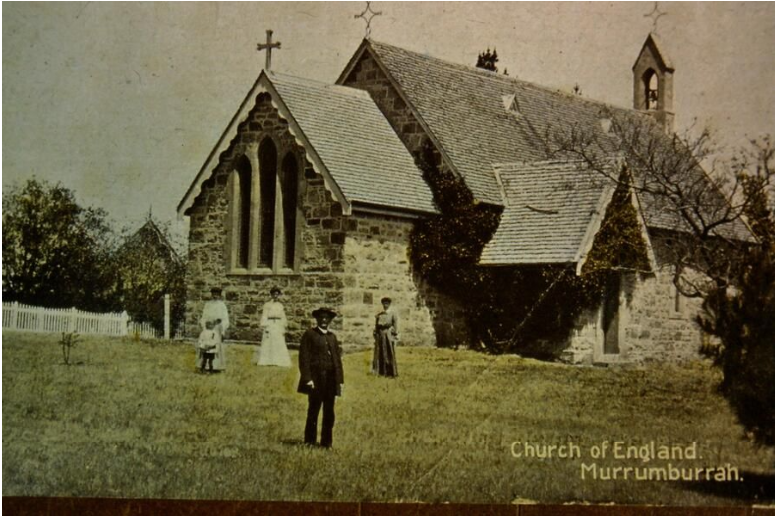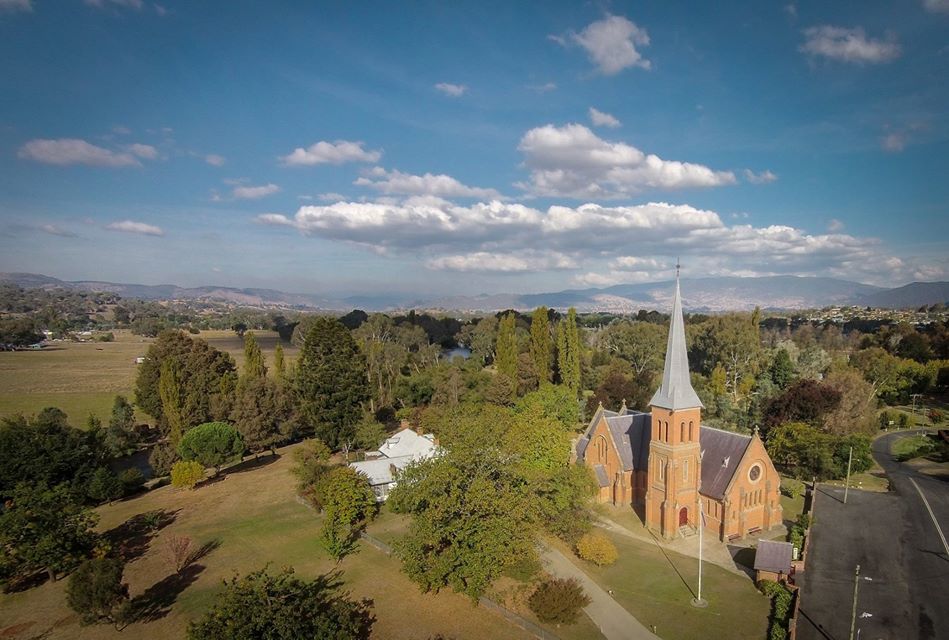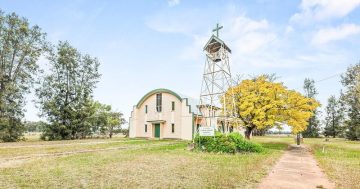
An early image of St Paul’s Anglican Church at Murrumburrah Harden. Source: Supplied.
Two of southern New South Wales’ oldest Anglican churches – St Paul’s in Murrumburrah Harden and All Saints’ in Tumut – are each gearing up to celebrate a remarkable milestone: 150 years since their foundation stones were laid.
Though separated by more than a hundred kilometres, the histories of these churches are remarkably similar – a testament to the grit, faith, and determination of early settlers who built them in often harsh, remote and testing conditions, guided by little more than hope and hard work.
The story of St Paul’s Anglican Church begins with a pioneering journey of faith.
In March 1870, Bishop Mesac Thomas, the first bishop of the Goulburn diocese, travelled by coach to Murrumburrah, holding a service in Allsop’s Commercial Hotel.
Recognising the need for a permanent church presence, he asked lay reader and teacher John Miller to move, with his wife Rebecca and their nine children, from Goulburn to the district.
The Millers set out in a four-horse cart along rough, muddy tracks, often getting bogged and forced to unload and reload their wagon just to keep moving.
They had no guarantee of a stipend – only a mission.
With the support of the Barnes and Allsopp families – early settlers who helped shape Murrumburrah through their businesses and civic contributions – Miller was able to establish regular services in Murrumburrah and Cootamundra, laying the foundations for what would become the Anglican Church in the region.
In 1875, the foundation stone of St Paul’s – accompanied by several newspapers and coins of the day – was laid by Mrs David H Campbell of “Cunningham Plains” on a plot atop a hill in Swift Street, near the centre of the town, marking the beginning of a spiritual home that would serve generations.
The building – a modest Victorian-era style typical of rural NSW, featuring a rectangular nave, a steeply pitched roof and simple stone construction – was completed in 1876 and consecrated eight years later, in 1884, once construction debts were cleared.
Arched windows and the sanctuary’s chancel give the interior a quiet Gothic Revival character, while later additions and furnishings mark the building’s evolution over nearly 150 years.
A sanctuary was added in 1892, and in 1922 the roof was replaced and new furnishings – including a prayer desk, pulpit and eagle lectern – were installed.
Remarkably, the original pews from 1876 are still in use today.
Despite the age and some structural challenges – the roof has required repairs and some services now take place in the parish hall – St Paul’s remains a steadfast centre of community life.
The parish will mark its sesquicentennial celebration on 18-19 October with an open day, historical displays, a free barbecue, children’s games and a performance by the Hilltops Choir on Saturday.
On Sunday, the Bishop of Canberra and Goulburn, the Right Reverend Dr Mark Short, will lead a thanksgiving service followed by lunch.
A commemorative book is being prepared and the parish is seeking contributions of photos, memorabilia, or family stories.
Anyone with items or memories to share can contact Rev Don Jamieson* at [email protected]

All Saints’ Anglican Church at Tumut. Photo: John Stanfield.
Further south, All Saints’ Anglican Church in Tumut also marks 150 years.
The first resident Anglican clergyman, Reverend Samuel Fox, arrived in 1855, lodging with the Bridle family at “Bombowlee”.
His ministry spanned vast areas, travelling by horse or carriage across the South West Slopes and Riverina where early worship often took place in makeshift locations.
That included the original Anglican place of worship in Tumut, a “barn church” constructed in 1857.
This structure was a temporary measure, referred to as an “Episcopalian barn”, serving the community until a permanent church could be built.
The foundation stone of All Saints’ was laid in 1875.
Renowned colonial architect Edmund Blacket, designer of Sydney University’s Quadrangle, drew up the plans, though he never saw the completed building.
Also built in Gothic Revival style, All Saints’ was finished in 1878, with its distinctive tower and spire, donated by local pastoralist Mr CD Bardwell, added in 1882.
Constructed in red brick with cement dressings – unusual for Blacket, who normally used stone – the church features fine stained glass, including an east window by John Hardman & Sons and a rose window depicting the four evangelists.
The organ, built in 1926 by Sydney builder TC Edwards, incorporates English pipework from Alfred Palmer & Sons.
It was rebuilt in 1963 and restored in 1990, remaining one of the most impressive regional church organs in NSW.
Major restoration in 1990 replaced the roof with Welsh slate, re-carved wooden gargoyles, and repainted the interior in heritage colours, preserving the building’s architectural significance.
All Saints’ Anglican Church will mark its 150th anniversary with a special celebration at 9 am on Sunday 2 November.
The service will commemorate the laying of the foundation stone of the current church building and will be followed by a morning tea, providing an opportunity for fellowship among parishioners and visitors.
A historical display will also be featured, showcasing photographs, artifacts and other items that reflect the rich history of the church.
As part of the celebrations, a replacement plaque will be unveiled to mark this significant milestone.
The parish invites all members of the community to join in the occasion and celebrate the enduring faith and heritage of All Saints’ Church.
*History of St Paul’s Anglican Church courtesy of Reverend Don Jamieson.








